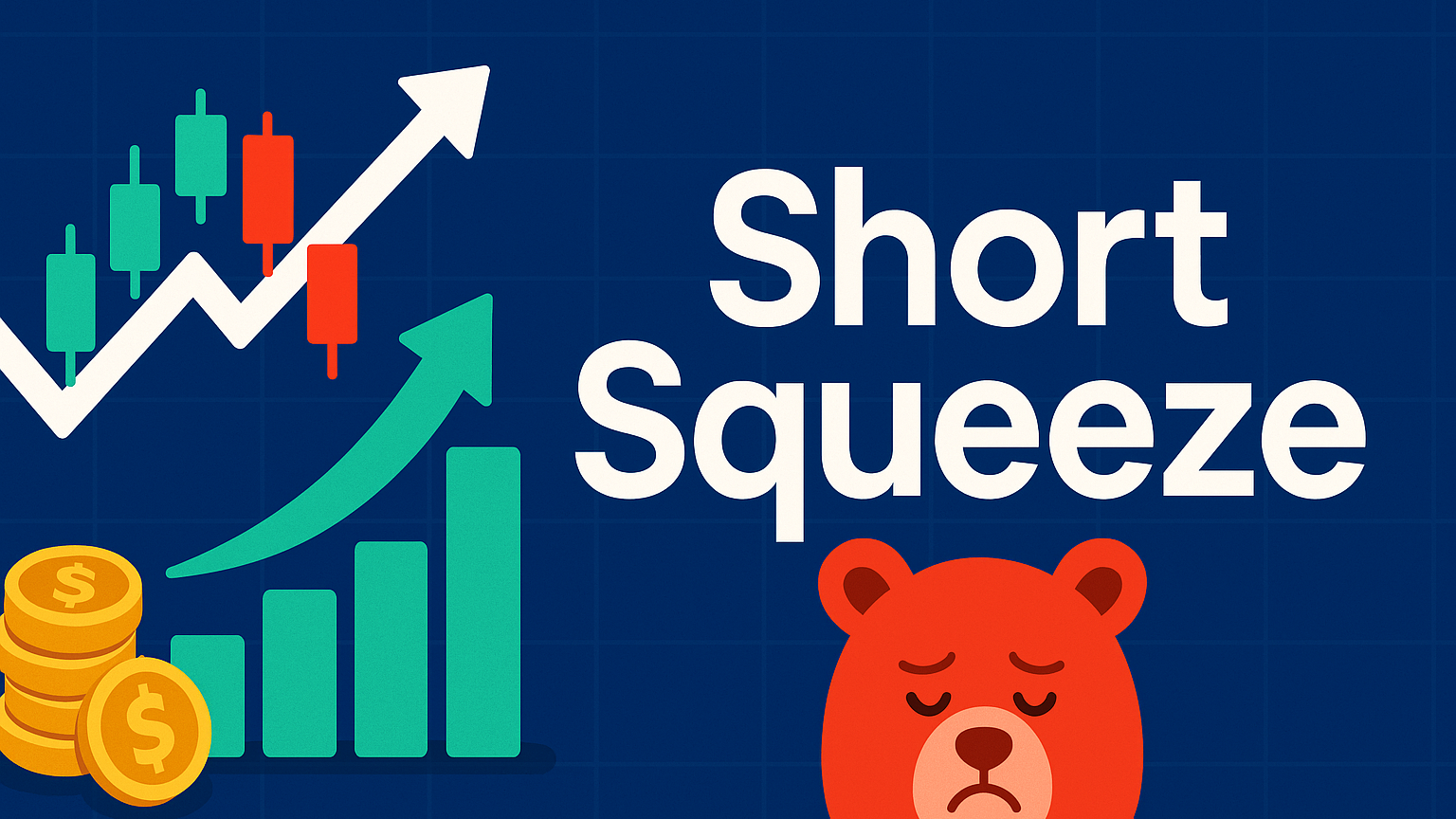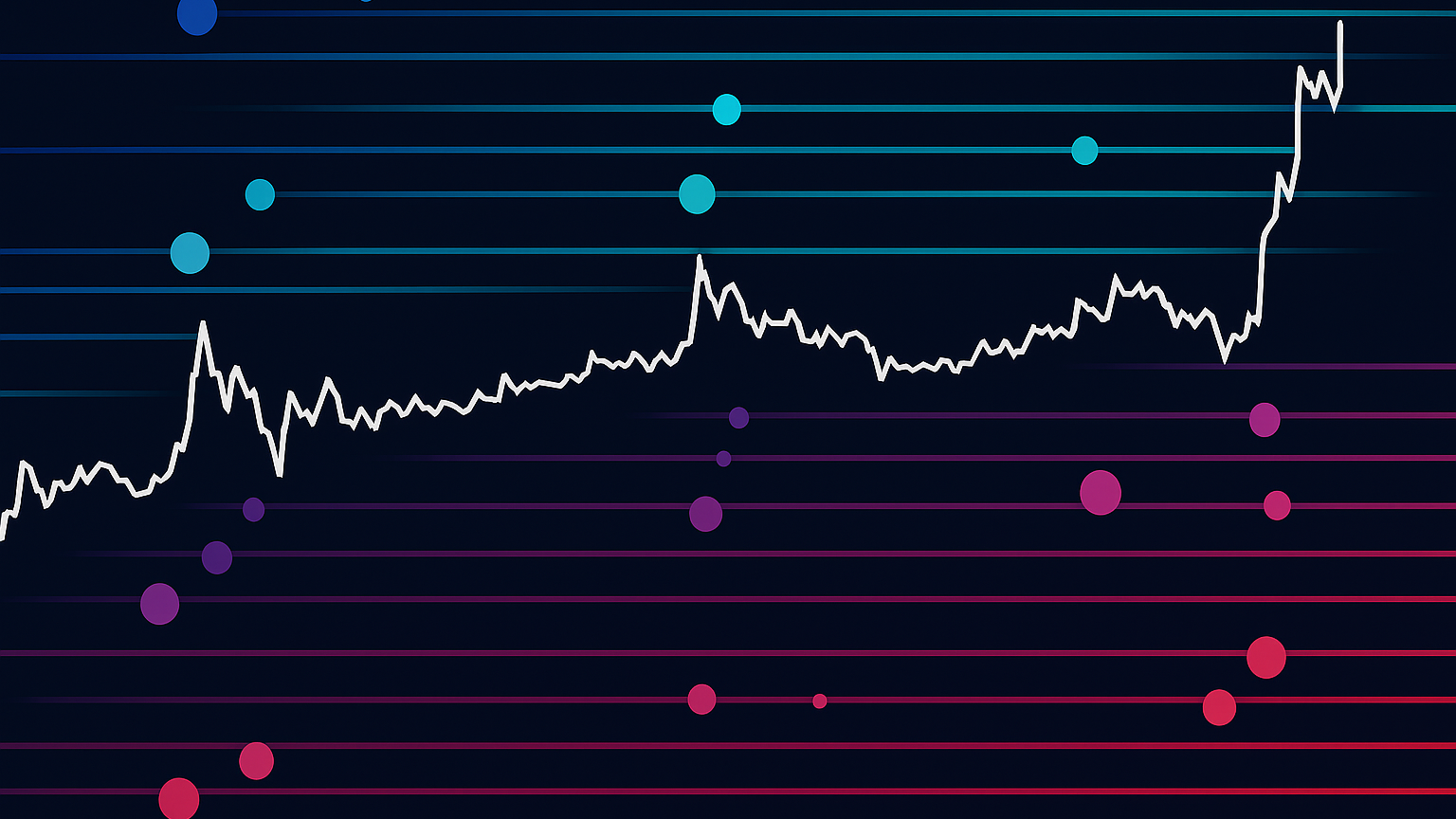Learn how short squeezes can dramatically impact stock prices, driven by high short interest and market catalysts.
A short squeeze happens when a stock's price rises quickly, forcing short sellers to buy back shares to limit their losses. This creates a feedback loop, driving prices even higher. Key factors include high short interest (over 20%) and triggers like positive news or unexpected buying activity.
Key Signals of a Short Squeeze:
- Short Interest Ratio: 5+ days to cover signals risk.
- Short Float %: Above 30% indicates high potential.
- Catalysts: Strong earnings, mergers, or low float stocks.
How It Works:
- Initial Trigger: Positive news or buying pressure starts a price increase.
- Forced Covering: Short sellers face margin calls, buying back shares.
- Peak Momentum: FOMO (Fear of Missing Out) buying amplifies the surge.
Risk Management Tips:
- Limit position sizes and set stop-loss orders.
- Use staged exits to lock in profits.
- Short sellers can hedge with call options to reduce losses.
Famous examples include GameStop (2021), where the price soared from $17 to $483 due to retail buying, and Volkswagen (2008), where corporate moves pushed the stock from €210 to over €1,000. Both highlight how short squeezes can create massive, unpredictable price swings.
What is a Short Squeeze?
How Short Squeezes Work
A short squeeze happens when rising stock prices force short sellers to buy back shares, pushing prices even higher. Knowing how this works is key for traders and investors alike.
Key Factors Behind Short Squeezes
Two main factors drive a short squeeze: high short interest and specific triggers. Short interest shows the percentage of a company's shares that have been sold short. When this figure climbs above 20%, it signals heavy bearish sentiment, setting the stage for a potential squeeze.
Another important metric is the days to cover ratio, which measures how long it would take for short sellers to exit their positions based on average trading volume. A higher ratio means it takes longer to close out short positions, which can intensify the squeeze.
Phases of Price Movement During a Squeeze
A short squeeze typically unfolds in three distinct phases:
| Phase | Description | Impact |
|---|---|---|
| Initial Trigger | Positive news or unexpected buying pressure | Moderate price increase |
| Forced Covering | Margin calls force short sellers to buy back | Rapid price surge |
| Peak Momentum | Broad short covering and FOMO buying | Extreme price spikes |
A clear example of this was GameStop's January 2021 short squeeze. The stock's short interest exceeded 130% of its available shares. This imbalance, coupled with coordinated retail buying, sent the stock soaring from $17 to an intraday high of $483.
Margin calls often act as fuel for these events. As stock prices rise, brokers demand more collateral from short sellers. If they can’t meet these demands, they’re forced to buy shares to close their positions, adding even more upward pressure. When multiple large short sellers face this at once, it can lead to a chain reaction of forced buying.
Finding Short Squeeze Setups
To uncover potential short squeeze opportunities, traders rely on a mix of short interest data, technical analysis, and monitoring key market triggers. Let’s dive into the details.
Reading Short Interest Data
Short interest data offers insight into market sentiment and the likelihood of a short squeeze. Here are the main metrics to track:
| Metric | What It Tells You | Key Signal for a Squeeze |
|---|---|---|
| Short Interest Ratio | Days needed to cover all short positions | 5+ days could indicate squeeze risk |
| Short Float % | Percentage of shares sold short relative to float | Over 30% often signals high squeeze potential |
| Short Interest Change | Trends in short positions over time | A rapid increase suggests growing bearish sentiment |
Both Nasdaq and NYSE release short interest data twice a month. Pay close attention to stocks with short interest above 30% of the float that are trading below their 200-day moving average. This combination often points to oversold stocks that could reverse.
Common Squeeze Triggers
Certain events can act as catalysts for a short squeeze. Keep an eye on:
- Unexpectedly strong earnings or positive company announcements
- Strategic moves like mergers, acquisitions, or partnerships
- A surge in institutional buying
- Stocks with a low float and high short interest
"A short squeeze is a high-risk situation and it may cause havoc in the market, but most don't last forever. Most eventually subside." - Charles Schwab
Technical Analysis Methods
Technical indicators can help pinpoint when a short squeeze might occur. Focus on these signals:
- Oversold Conditions: A Relative Strength Index (RSI) below 20 can hint at a reversal.
- Volume Spikes: Unusually high trading volume, especially if prices are rising, may signal the start of a squeeze. For instance, AMC Entertainment’s 2021 squeeze saw its stock soar over 3000% between January and June, accompanied by massive volume increases.
- Price Action: Look for bullish divergences, where price lows fall faster than indicator lows, as a potential sign of upward momentum.
For the best results, combine technical signals with short interest data and fundamental analysis. Stocks showing multiple squeeze indicators at once often present the strongest opportunities. This approach also helps manage risks in the volatile environment of short squeezes.
Risk Control in Short Squeezes
Short squeezes come with intense price swings, making risk management absolutely essential.
Setting Position Limits and Stops
Handling your exposure during a short squeeze is crucial. Here are some practical ways to manage risk:
| Risk Component | Suggested Approach | Why It Matters |
|---|---|---|
| Position Size | Keep trades small by using a limited portfolio share | Reduces risk during sudden, sharp price moves |
| Stop-Loss Level | Use tight stops based on your entry price | Minimizes losses if the squeeze intensifies |
| Profit Taking | Plan several exit levels | Locks in profits as the stock price surges |
Using limit orders is another smart move to prevent unexpected trades during volatile periods.
"Because it's so tough to identify a short squeeze until it's already happening, many short sellers are convinced it's important to have exit strategies for positions." - Charles Schwab
These strategies are helpful for most traders, but short sellers need to take extra steps to protect themselves.
Protection for Short Sellers
Short sellers face unique risks, so additional safeguards like hedging are critical. Options are a popular tool for this purpose.
For instance, if you're shorting 100 shares at $76.24, buying a call option with a $75 strike price can offset potential losses. In one example, when the stock climbed to $85, the $876 loss on the short position was partially balanced by a $600 gain on the call option, leaving a net loss of $276.
Here are some protective strategies to consider:
| Strategy | Benefits | Drawbacks |
|---|---|---|
| Call Options Hedge | Limits your maximum loss | Requires paying for the option premium |
| Bear Put Spreads | Potentially cheaper than buying calls outright | Provides only partial protection |
| Staged Exits | Reduces exposure gradually | May miss out on full profit potential |
Keep an eye on technical indicators and ensure you have sufficient margin to avoid forced liquidations.
Major Short Squeeze Examples
Financial markets have seen some extreme short squeezes that have dramatically impacted trading strategies and risk management. These events show how a mix of technical and fundamental factors can drive massive market swings.
GameStop (2021): Power of Social Media
The GameStop short squeeze showcased the growing influence of social media on retail trading. It all started when users on r/wallstreetbets noticed that 140% of GameStop's float was shorted. This set the stage for a massive, coordinated buying frenzy.
| Timeline | Impact |
|---|---|
| Initial Price | $17 per share |
| Peak Price | $483.00 intraday |
| Price Increase | Over 1500% |
| Reddit Activity | 73M page views in 24 hours |
| Community Growth | 1.5M new users overnight |
Elon Musk's tweet, "Gamestonk!!", added fuel to the fire, intensifying the buying spree and causing significant losses for institutional short sellers. For example, Melvin Capital reported a 53% loss in January 2021.
"This was the French Revolution of Finance."
While GameStop highlighted the power of retail traders, the Volkswagen squeeze showed how corporate strategies can also create market chaos.
Volkswagen (2008): Corporate Strategy at Play

Unlike the retail-driven GameStop squeeze, Volkswagen's case in 2008 was triggered by corporate maneuvers. Porsche’s strategic accumulation of shares, combined with Lower Saxony's stake, left very little float available, leading to a sharp price surge.
| Date | Price Movement | Market Impact |
|---|---|---|
| Starting Price | €210.85 | Normal trading |
| Day 1 | €517.00 | More than doubled |
| Day 2 | €1,005.00 | Briefly became the world’s most valuable company |
| Total Value | €296 billion | Temporary market capitalization |
"It was one of the most painful days in my career. The pain among investors was unparalleled versus any other market scenario I have encountered."
Key Takeaways from These Squeezes
These examples underline the importance of staying alert to both social sentiment and corporate actions.
| Aspect | GameStop Insight | Volkswagen Insight |
|---|---|---|
| Trigger | Social media coordination | Changes in corporate ownership |
| Duration | Weeks of volatility | Days of intense movement |
| Risk Signal | 140% short interest | Limited available float (under 6%) |
Both cases show how limited supply and forced buying can lead to dramatic price increases. Traders should keep a close eye on social media discussions and corporate ownership changes as early warning signs of potential squeezes.
Trading Tools for Short Squeezes
To navigate short squeezes effectively, traders rely on a mix of technical analysis tools and market data platforms. These resources provide insights to identify and time these volatile market moves.
LuxAlgo: Technical Indicators
LuxAlgo provides advanced technical analysis solutions on TradingView, featuring a range of price action tools, signal overlays, and exclusive screeners that help detect early signs of a short squeeze through sophisticated pattern recognition and momentum analysis. One standout feature is the Price Action Concepts (PAC) toolkit, designed to identify potential squeeze setups. For $39.99/month (Premium plan), users can also access custom alerts and scan for multiple squeeze opportunities.
| Feature | Function | Benefit |
|---|---|---|
| Oscillator Matrix | Tracks real-time divergences | Highlights momentum shifts before squeezes |
| Signals & Overlays | Uses multiple signal algorithms | Detects unusual price and volume activity |
| AI Backtesting | Optimizes trading strategies | Tests squeeze setups across different timeframes |
These solutions work well alongside broader market analysis platforms, creating a comprehensive approach to spotting short squeezes.
Market Analysis Platforms
While LuxAlgo focuses on technical signals, platforms like ShortSqueeze.com provide critical market data. Covering over 16,000 stocks, ShortSqueeze.com delivers statistics like short interest ratio, short float percentage, and daily short sale volume (with a 20-minute delay). It also includes a real-time ranking system for potential squeezes.
Key features to look for in market analysis platforms:
- Data Integration: Combine short interest data with options activity and social sentiment.
- Custom Alerts: Get notified when short interest ratios exceed 20%.
- Research Tools: Access detailed reports on short interest and ownership trends.
Top brokerages like Interactive Brokers, Charles Schwab, thinkorswim, and E*TRADE incorporate these functionalities into their trading platforms, streamlining both analysis and execution.
Conclusion: Short Squeeze Trading
Short squeeze trading requires a mix of careful analysis and disciplined execution. By combining technical insights with solid risk management, traders can better position themselves for these volatile opportunities.
Trading Guidelines
To navigate short squeezes effectively, focus on these key aspects:
-
Spotting Opportunities
Look for stocks with short interest ratios above 20%, as these often signal potential setups. Keep an eye on technical indicators showing oversold conditions and track institutional ownership changes for additional clues. -
Timing Your Entry
Timing is critical. Watch for catalysts like earnings reports or significant news events. Pay attention to volume spikes, price action, and overall market sentiment, including trends within specific sectors. -
Managing Risk
Given the unpredictable nature of short squeezes, strict risk controls are essential. Use stop-loss orders and limit your position sizes to manage potential losses. Staged entries and exits can also help mitigate risk, along with maintaining sufficient margin levels.
Market Effects
Short squeezes don’t just impact individual stocks—they can ripple through the broader market. For example, during recent events, the CBOE VIX Index spiked to 33.09, far above its 15-year average of 18.9, showing their influence on market volatility.
| Impact Area | Short-Term Effect | Long-Term Implication |
|---|---|---|
| Price Volatility | Sudden spikes (e.g., up to 1,600% in GameStop) | Normalizes within 2-4 weeks |
| Market Sentiment | Surge in retail investor activity | Increased scrutiny of short selling |
| Risk Metrics | Elevated VIX levels | Strengthened risk management protocols |
While short squeezes can yield significant profits, they are rare and often unpredictable. Research shows these events are difficult to forecast consistently. Instead of chasing momentum, successful traders prioritize thorough preparation, precise execution, and strong risk management strategies.







